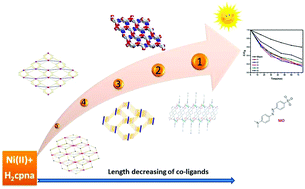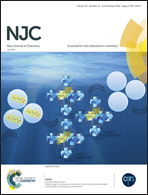Structural assembly from 1D to 3D motivated by the linear co-ligands, and the magnetic and photocatalytic properties of five NiII coordination polymers with 5-(4′-carboxylphenyl)nicotinic acid†
Abstract
Five novel nickel(II) coordination polymers, namely, [Ni(cpna)(4,4′-bipy)(H2O)2] (1), [Ni(cpna)(1,4-bbi)(H2O)]·H2O (2), [Ni4(cpna)4(H2O)8] (3), [Ni2(cpna)2(4,4′-bbpy)(H2O)] (4), and [Ni (cpna)(1,4-bibz)0.5(H2O)]·H2O (5) (H2cpna = 5-(4′-carboxylphenyl)nicotinic acid; 4,4′-bipy = 4,4′-bipyridine; 1,4-bbi = 1,4-bisbenzimidazole; 4,4′-bbpy = 4,4′-bis(imidazol-1-ylmethyl)biphenyl; 1,4-bibz = 1,4-bis(1-imidazoly)benzene), have been synthesized under hydrothermal conditions based on H2cpna and four different linear N-donor co-ligands. Structural analyses show that all Ni(II) ions lie in slightly distorted six coordinated octahedral geometries. Complexes 1–5 exhibit a variety of architectures: 1 features a 1D chain structure, complex 2 possesses a 2D network, and compounds 3–5 display a 3D framework with dimer Ni2 units, which might be affected by the coordination modes and lengths of the co-ligands. The magnetic and photocatalytic properties were investigated. The variable-temperature magnetic susceptibilities indicate that weak ferromagnetic interactions exist between two adjacent Ni(II) ions of 2, while the other compounds show antiferromagnetic exchange interactions. All of them could accelerate the degradation rate of MO under visible light irradiation, especially compound 2.



 Please wait while we load your content...
Please wait while we load your content...